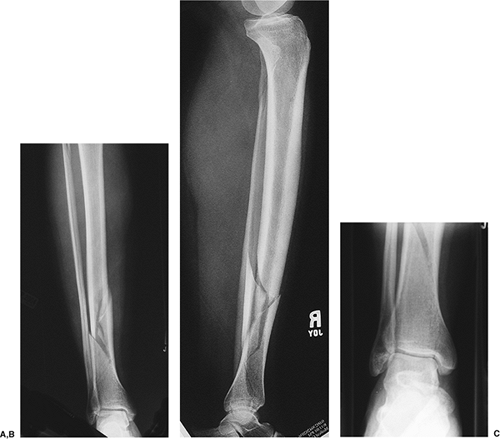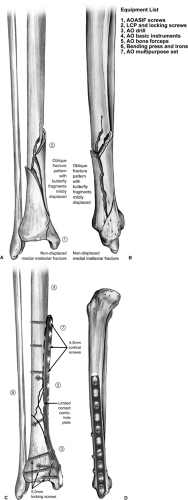Tibial Shaft Fractures: Open Reduction Internal Fixation
Brett R. Bolhofner
Indications/Contraindications
Open reduction internal fixation (ORIF) through use of plates and screws may be carried out for any fracture of the tibia in which soft-tissue conditions are satisfactory. Although intramedullary interlocking nails have become popular for the treatment of many tibial-shaft fractures, plating remains a viable alternative (1). Compared with an intramedullary implant, plating of the tibia requires greater attention to the condition of the soft tissues, more preoperative planning, and greater attention to surgical detail during the procedure.
Strong indications for plate osteosynthesis of tibial-shaft fractures are the presence of compartment syndrome, neurovascular injury, compromised medullary canal, or compromised access to the medullary canal due to associated injury (2,3).
Relative indications for ORIF include the following conditions: polytraumatized patients, open fractures, late loss of reduction with closed treatment, segmental injury, fractures that extend into either the knee or ankle joint, fractures of the proximal and distal one third of the shaft, and fractures in patients whose livelihood or recreational habits demand perfect restoration of length and rotation (2,3). Certain fracture patterns may be better anatomically restored by plating. For example, a distal, spiral, oblique fracture or a simple oblique fracture with a relatively steep fracture plane may be best treated with a plate as will fractures that extend to the ankle joint.
Relative contraindications to plate osteosynthesis include isolated, displaced, diaphyseal fractures, which may be better treated with a locked intramedullary nail. Grossly contaminated open fractures, which will require serial débridements, are best treated with an external fixator.
A careful assessment of the soft-tissue envelope at the time of injury and at the time of surgery is essential because its condition influences the timing of the surgical procedure. The Tscherne classification may be helpful in evaluating and assessing the soft-tissue
injury associated with a particular fracture pattern (4). In patients whose soft tissue does not permit early internal fixation because of swelling, abrasions, or blisters, may benefit from a 10 to 14 day waiting period. The skin should have a very fine wrinkled texture or appearance before plate osteosynthesis is undertaken.
injury associated with a particular fracture pattern (4). In patients whose soft tissue does not permit early internal fixation because of swelling, abrasions, or blisters, may benefit from a 10 to 14 day waiting period. The skin should have a very fine wrinkled texture or appearance before plate osteosynthesis is undertaken.
When soft-tissue conditions are satisfactory, the tibia is well suited to plate fixation. It has a large subcutaneous surface that may be used for stabilization without the muscles being stripped (5). Because no muscle needs to be stripped from it, the medial face of the tibia is, in fact, an ideal plating surface. Most of the poor results and subsequent criticisms of tibial plating were due to poor soft-tissue technique, inappropriate implant use, and poor reductions.
Preoperative Planning
The initial assessment of the soft tissues and the radiographic pattern of the fracture is carried out immediately. Attention to the neurovascular status as well as the status of the muscle compartments is mandatory. The presence of soft-tissue contusion, skin necrosis, swelling, compartment syndrome, skin abrasion, or any wounds is carefully documented. Anteroposterior (AP) and lateral views of the tibia, to include both knee and ankle joint, must be obtained (Fig. 28.1).
The timing of the internal fixation is based primarily on the condition of the soft tissues. ORIF of the tibia should only be carried out when satisfactory skin and wound conditions permit a tension-free soft-tissue closure at the conclusion of the procedure. If these conditions do not exist, then internal fixation should be postponed. The extremity should be splinted, casted, or a temporary, spanning, external fixator applied until more favorable conditions exist. If surgery is delayed, the limb should be elevated to help resolve any swelling. Necrotic soft tissue should be well demarcated and excised at the time of surgery. A gastrocnemius, rotational, muscle flap will be required for proximal tibia fractures. In the distal tibia, a free tissue transfer or a fasciocutaneous rotational flap may be needed. When satisfactory soft-tissue conditions are present, the procedure may be carried out with a well-conceived preoperative plan and a surgical tactic.
AP and lateral radiographs of the injured extremity should be obtained. If the fracture is complex or if deformity is significant, an AP and lateral radiograph of the unaffected side or an AP and lateral radiograph of the affected extremity in traction may help the surgeon better conceptualize the fracture pattern. The preoperative drawings, which need not be of artistic quality, should be fashioned so that a step-by-step procedure from start to finish is outlined in a simple fashion (Fig. 28.2). Because the preoperative plans are displayed in the operating room at the time of the surgery, they should list any equipment that might be required. The steps of the procedure are indicated directly on the preoperative plan in numeric order.
The equipment required to carry out the procedure will be AO/ASIF screws and plates including the limited-contact dynamic compression (LCDC) plate with combination holes (Synthes, Paoli, PA). Basic instruments, an AO drill, bone forceps, and associated small soft-tissue retractors and elevators are also required.
Locking the screws to a plate may be an advantage when bone quality is poor due to osteoporosis or when the distal fragment is relatively short. Using a locked construct will allow the creation of a fixed angle device, and when applied to one or the other major fragments, it will allow the plate to be used to facilitate the reduction (i.e., indirect technique). Precontoured plates are available for some fracture patterns and applications. A locked plate must be accurately contoured if it is to be used as a reduction tool because a locked screw will not pull the plate and bone together. In some instances, a more stable construct can be created with locking screws. Preoperative planning may be more difficult because of the uncertainty of the locked screw projections after plate contouring.
Assumption of basic AO technique as well as the use of locking screws is assumed. A complete discussion of locking technique is beyond the scope of this chapter.
Surgery
When the soft tissues are satisfactory for surgery and a preoperative plan has been established, the procedure may be initiated (Fig. 28.3). Intraoperative findings (such as nondisplaced fracture lines or unrecognized comminution) may contradict the preoperative plan for trauma reconstruction (such as for an osteotomy). In such cases, the order of the preoperative plan may need to be altered.
The patient is placed in the supine position on a regular operating-room table. A tourniquet is not required for the procedure but may be used if desired. Use of either general or spinal anesthesia is satisfactory. The entire leg is prepped from the toes to the groin. Prophylactic intravenous antibiotics, usually a single preoperative dose of cephalosporin, is
recommended. The location and length of the incision is drawn on the skin before application of an adhesive iodine-impregnated drape (Fig. 28.4). I prefer to carry out the procedure in the seated position at the foot of the table with the surgical assistant also seated.
recommended. The location and length of the incision is drawn on the skin before application of an adhesive iodine-impregnated drape (Fig. 28.4). I prefer to carry out the procedure in the seated position at the foot of the table with the surgical assistant also seated.
Surgical Approach
A long anterior incision is placed 1 cm lateral to the tibial crest and corresponding to Langer’s lines (Fig. 28.5) (1). The incision is curved gently at its distal portion at the level of the metaphyseal flare in the supramalleolar region. A long surgical incision is preferred because it allows satisfactory exposure of the tibia and allows the surgeon to avoid unnecessary, vigorous, skin retraction, particularly on the medial skin flap (Fig. 28.6A) (6). The saphenous vein or nerves need not be sacrificed in the distal portion of the incision because the plate may be placed beneath these structures, leaving them completely intact (see Fig. 28.6B). They should be dissected only enough to allow passage




Stay updated, free articles. Join our Telegram channel

Full access? Get Clinical Tree










